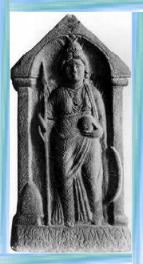|
The Circle of Light Issue #2 Date: 13/5/2001  In this issue: Editor's Note Articles: Daily Divination by Taliana WolfSpirit New Sections: Psychic Gifts: Astral Travelling Reviews Teen Witch and Spiritonline Book of Shadows Regular Sections: Animal Magick: Armadillo Bluebird Crystals by Apasi Gods and Goddesses of Witchcraft: Loki Brigit Jupiter Pagan Band Review Moving Breath Your Say: Submit Your Say Read What Others Say Submit Your Own Work      |
Brigit  The goddess Brigit is known by many names- Brighid, Bride, Briid, Brigindo and Brigantia but the most common spelling used is Brigit. She is seen by some to be the parallel to the Greek Goddess Artemis while others believe that she is another name for the Goddess Hecate and is a triple goddess. She is a Celtic goddess whom seems to have originated in Ireland. Many people get confused as another lady born in Ireland by that name later became a saint so it is easy to confuse the goddess Brigit and the saint Brigit; they even have festivals on the same day. Some even believe that the Saint Brigit is merely an attempt to cover up the worshipping of the Goddess Brigit after the Christianization of Ireland. She also, however, has recognizable equivalents in all Celtic lands and is known as the goddess of smiths, poets (to whom she gives inspiration) and healers. Her name means Exalted One or High One and she is a solar, or sun goddess, which had lead to many names such as Bright One, Bright Arrow and Fiery Arrow. Like Artemis and Diana, it is believed that Brigit watches over childbirth. Because of the Christianization of much of the old Irish myths and beliefs she is, by many considered the midwife to the Virgin Mary and the foster mother of Christ. Her festival is held on the first of February in the northern hemisphere and the first of August in the southern hemisphere. This is due to the difference in seasons that causes the festivals that are based on seasons to be six months later (or earlier- depending on your perspective). This festival is known as Imbolc. It is held at this time because it was used to celebrate the lactation of the ewes, symbolic of new life and also the coming of the spring. Due to this she also takes on the aspect of a fertility figure. Many traditions, which have been in some way connected to the reverence of this goddess, still carry on till this very day. Some examples of these are parades with the image of the Saint Brigit, who is also seen as the goddess, adorned in greenery. A churn staff in Ireland is fashioned to look like a woman then dressed is called Brideog or Little Bride and straw crosses are put in the eves of houses to protect the house form fire: these are called Brigit crosses. During the time of Imbolc the goddess Brigit is believed to rekindle the fire within the Earth and prepare the way for spring. This is meant to be shown through the first flowing of milk. During this time Agricultural tools are reconsecrated for use, ousehold fires and the fire of the smiths forge are blessed by the Goddess (often by a woman who plays the role of Brigit) and talismans are made for the protection of homes. Unfortunately, because Ireland was not conquered by the Romans, but Christianized, no pagan imagery, which might have been left in retaliation, has been left. Due to this the evidence of the belief in the goddess Brigit comes from the later Christian writers. Name: Brigit Silversweet  Email Silversweet at: silversweet_tbos@hotmail.com Disclaimer: All the information included in this article has been reproduced from the following sites. The author and this magazine own none of the information and take no legal responsibility for its reproduction or use. http://www.clannada.org/pantheon/bride.html http://gaia.faithweb.com/brigit.html http://homepages.nildram.co.uk/~fealcen/essayb.htm http://angelfire.com/biz5/MyBeliefs/images/Brighit.html |
